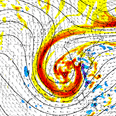-
Posts
5,750 -
Joined
-
Last visited
Content Type
Profiles
Blogs
Forums
American Weather
Media Demo
Store
Gallery
Everything posted by brooklynwx99
-
seems like the transition to a better pattern begins a bit before Christmas and will continue through the holiday week. nice to see the shift moving forward in time doesn’t look good before the 23rd or so, but we should see the AK trough retrograde and the positive heights build into the NAO domain via wave breaking. not a bad spot to be in, and it gives a good launching pad into Jan
-
people forget that jet extensions lead to +PNA. we want those jet retractions are associated with La Niña and -PNA
-
depends on what subforum you're in
-
they have looked the same for the last two to three weeks and have been moving forward in time. remarkably consistent, actually
-
here you go
-
I don't think that's going to happen. there isn't really any support for such a solution
-
will have to wait until Christmas onward for anything better, which is fine and has been known by most (hopefully)
-
I think people easily forget that NYC averages a grand total of 4.7" of snow in December. that can easily be made up given that the pattern should become more favorable late in the month... not exactly worried for the rest of the winter given the weak SPV and the fact that a -NAO December correlates very well to strong blocking for the rest of the year Ninos are backloaded winters
-
-
I'm not seeing that here. looks like a clean progression east. of course you're going to get some forcing lingering back as the wave progresses
-
GEFS showing the transition well as the AK trough retrogrades and the PNA rises. SE trough starting to develop
-
GEFS showing the transition well as the AK trough retrogrades and the PNA rises. SE trough starting to develop
-
pretty nice to see the GEFS in such lock step agreement with the beginning of the weeklies. modeling has been very consistent on the 20-25th for a pretty wholesale change of the pattern hasn’t been getting pushed back, either
-
weeklies are mint through mid-Jan
-
El Nino Decembers are usually just crappy regardless of MJO, honestly
-
I think phase 8 is warm in El Nino Decembers, not later in the year. it's a cold signal for Jan and Feb either way, the MJO becomes a lot more favorable and there are reasons for optimism late-month
-
nothing has been pushed back. the weeklies have shown the same thing for like the past two weeks now
-
who is calling for Arctic cold? nobody worth taking seriously, really. the pattern does become more favorable late in the month as the AK trough retrogrades into more of a traditional Aleutian LP and the PNA increases. there is good agreement on that
-
yup, just had a weird wave break and it was off to the races. models are notoriously bad at modeling that kinda stuff so hopefully we can see that gain some steam
-
pretty favorable trend in the Pacific mid-month... PNA looks much better. nice to see this kind of trend in the medium range. probably just meaningless cold, but still
-
pretty favorable trend in the Pacific mid-month... PNA looks much better. might be able to pull off a light event given this pattern
-
pretty favorable trend in the Pacific mid-month... PNA looks much better. might be able to pull off a light event given this pattern
-
there will always be Pacific air in Ninos. they aren't super cold or anything, just stormy






